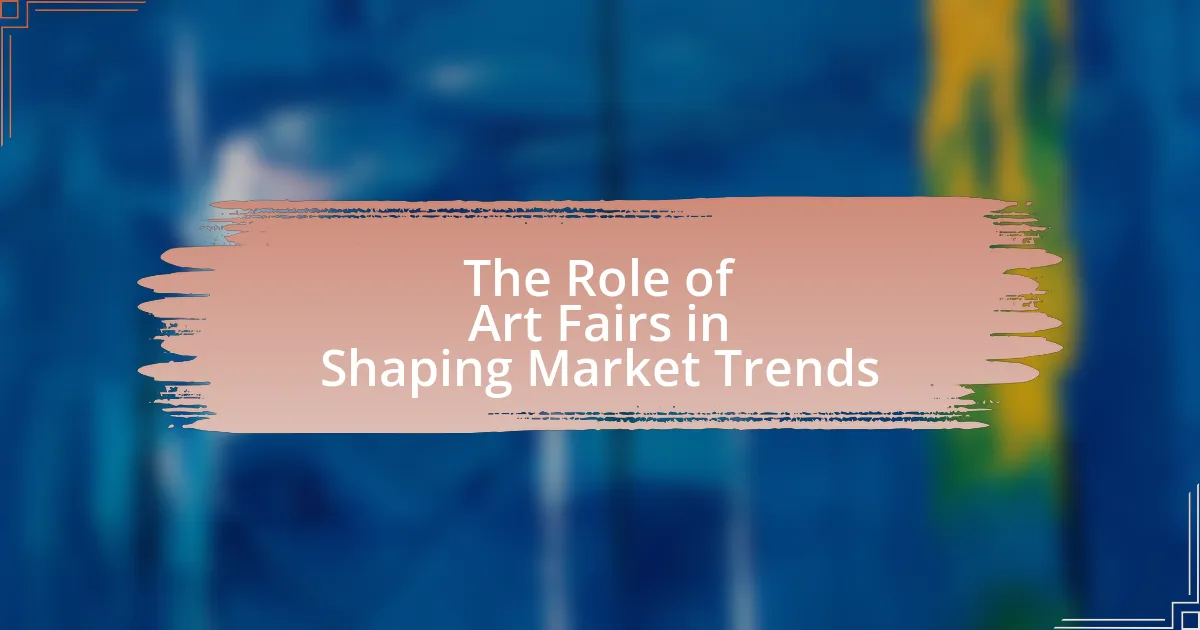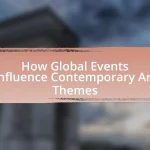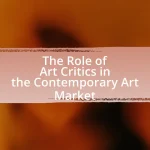Art fairs are pivotal in shaping market trends within the contemporary art landscape by providing a platform for galleries, artists, and collectors to engage and interact. These events enhance visibility for emerging artists, influence buyer preferences, and serve as indicators of market health through attendance and sales figures. Key features of art fairs, such as diverse artworks, networking opportunities, and exposure to new collectors, drive demand and impact investment decisions. Additionally, art fairs contribute significantly to local economies by generating revenue and attracting tourism, while also adapting to changing market dynamics through digital integration and sustainability initiatives.
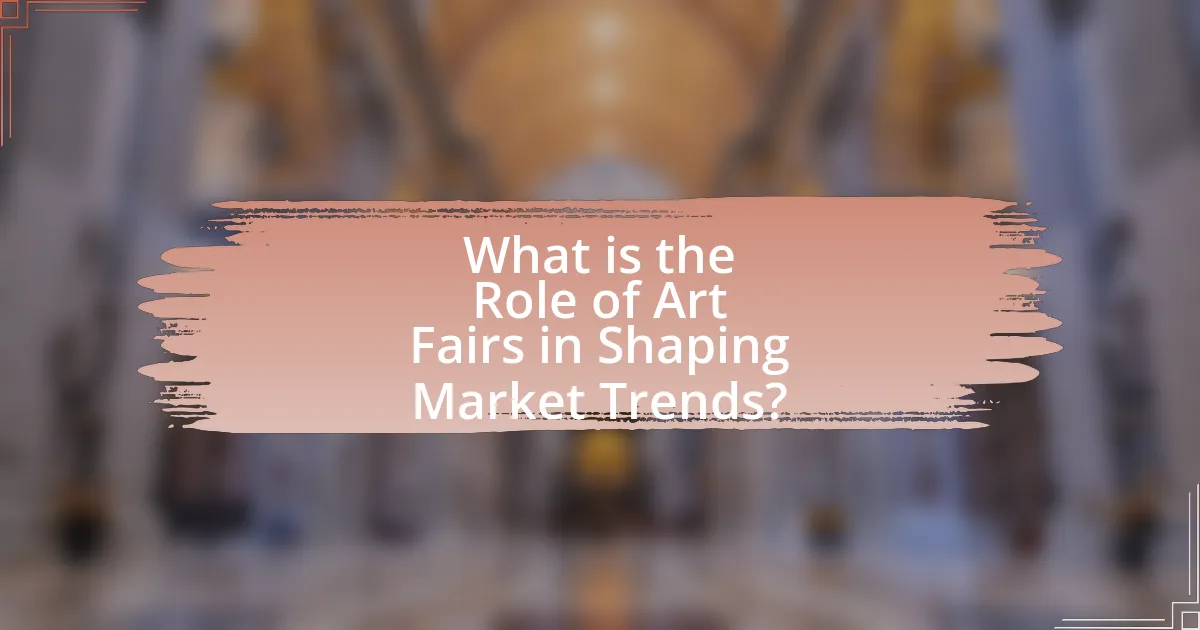
What is the Role of Art Fairs in Shaping Market Trends?
Art fairs play a crucial role in shaping market trends by providing a platform for galleries, artists, and collectors to interact and engage with contemporary art. These events facilitate the visibility of emerging artists and new works, influencing buyer preferences and market dynamics. For instance, the Art Basel fair has historically set trends by showcasing high-value artworks and attracting influential collectors, which can lead to increased demand for specific styles or artists. Additionally, art fairs often serve as barometers for market health, with attendance and sales figures reflecting broader economic conditions and collector confidence.
How do art fairs influence the contemporary art market?
Art fairs significantly influence the contemporary art market by providing a platform for galleries to showcase artists and their works, thereby driving visibility and sales. These events attract collectors, curators, and art enthusiasts, creating a concentrated marketplace where trends can emerge rapidly. For instance, the Art Basel fair has been known to generate millions in sales within days, illustrating how art fairs can accelerate the financial dynamics of the market. Additionally, participation in prestigious art fairs often enhances a gallery’s reputation, leading to increased demand for the artists they represent. This phenomenon is supported by the fact that many collectors use art fairs as a primary source for acquiring new works, which further solidifies the fairs’ role in shaping market trends.
What are the key features of art fairs that impact market trends?
Key features of art fairs that impact market trends include the concentration of diverse artworks, networking opportunities, and exposure to new collectors. The concentration of artworks from various galleries allows for comparative pricing and visibility, influencing buyer decisions and market valuations. Networking opportunities facilitate relationships between artists, collectors, and galleries, which can lead to increased sales and collaborations. Exposure to new collectors at these events can expand the market base, driving demand and shaping future trends. For instance, the Art Basel fair has historically set benchmarks for pricing and trends in contemporary art, demonstrating the significant influence of art fairs on market dynamics.
How do art fairs facilitate artist exposure and sales?
Art fairs facilitate artist exposure and sales by providing a concentrated platform where artists can showcase their work to a diverse audience, including collectors, curators, and art enthusiasts. These events attract significant foot traffic, often featuring hundreds of galleries and thousands of artworks, which increases visibility for participating artists. According to a report by Art Basel and UBS, art fairs accounted for 46% of the global art market in 2022, highlighting their importance in driving sales and connecting artists with potential buyers. Additionally, art fairs often include networking opportunities, panel discussions, and promotional activities that further enhance an artist’s profile and marketability.
Why are art fairs significant for collectors and investors?
Art fairs are significant for collectors and investors because they provide a concentrated platform for discovering and acquiring artworks, facilitating direct engagement with artists and galleries. This environment allows collectors to assess the market value of pieces in real-time, as art fairs often showcase a diverse range of artworks from various price points, enabling informed purchasing decisions. Additionally, art fairs serve as networking hubs, where collectors can connect with industry professionals, gain insights into market trends, and enhance their investment strategies. The presence of high-profile galleries and emerging artists at these events further validates the significance of art fairs in shaping market dynamics and influencing collectors’ and investors’ choices.
What advantages do collectors gain from attending art fairs?
Collectors gain several advantages from attending art fairs, including access to a diverse range of artworks, networking opportunities with artists and galleries, and insights into current market trends. Art fairs showcase a wide variety of pieces from different artists and styles, allowing collectors to discover new talent and expand their collections. Additionally, these events facilitate direct interactions with gallery owners and artists, fostering relationships that can lead to exclusive opportunities and collaborations. Furthermore, attending art fairs provides collectors with real-time information about market dynamics, pricing, and emerging trends, which can inform their purchasing decisions and investment strategies.
How do art fairs affect investment decisions in the art market?
Art fairs significantly influence investment decisions in the art market by providing a platform for exposure, networking, and market validation. These events showcase a diverse range of artworks, allowing collectors and investors to assess trends, gauge artist reputations, and identify emerging talents. For instance, the presence of high-profile galleries and established artists at fairs like Art Basel can enhance the perceived value of artworks, leading to increased demand and higher prices. Additionally, art fairs facilitate direct interactions between buyers and sellers, fostering relationships that can result in future transactions. According to a report by Art Basel and UBS, 70% of collectors stated that attending art fairs is crucial for their purchasing decisions, highlighting the fairs’ role in shaping investment strategies within the art market.
What role do art fairs play in promoting emerging artists?
Art fairs play a crucial role in promoting emerging artists by providing them with a platform to showcase their work to a diverse audience, including collectors, curators, and art enthusiasts. These events facilitate networking opportunities that can lead to sales, exhibitions, and representation by galleries. For instance, the Armory Show in New York has been instrumental in launching the careers of numerous artists by featuring them alongside established names, thereby increasing their visibility and credibility in the art market. Additionally, art fairs often include curated sections specifically dedicated to emerging talent, which further highlights their importance in shaping market trends and fostering new artistic voices.
How do art fairs provide platforms for new talent?
Art fairs provide platforms for new talent by offering exposure to a diverse audience of collectors, curators, and art enthusiasts. These events create opportunities for emerging artists to showcase their work alongside established names, facilitating networking and potential sales. For instance, the Armory Show in New York has been known to feature a dedicated section for solo presentations by emerging artists, which has led to increased visibility and career advancement for many participants. Additionally, art fairs often include awards and recognition programs that highlight new talent, further validating their presence in the art market.
What impact do art fairs have on the careers of emerging artists?
Art fairs significantly enhance the careers of emerging artists by providing them with exposure to a broader audience, including collectors, curators, and art enthusiasts. These events serve as platforms where emerging artists can showcase their work, gain visibility, and establish connections within the art community. For instance, participation in renowned art fairs like Art Basel or Frieze can lead to increased sales, representation by galleries, and invitations to future exhibitions. Research indicates that artists who exhibit at art fairs often experience a boost in their market value and recognition, as evidenced by a study published in the Journal of Cultural Economics, which found that artists who participated in art fairs saw a 30% increase in their sales and visibility within the first year following the event.
How do art fairs adapt to changing market dynamics?
Art fairs adapt to changing market dynamics by incorporating digital platforms, diversifying their offerings, and enhancing visitor experiences. The rise of online sales and virtual exhibitions has prompted art fairs to create hybrid models that combine physical and digital access, allowing galleries to reach a broader audience. For instance, Art Basel launched its online viewing rooms in response to the COVID-19 pandemic, which significantly increased participation and sales. Additionally, art fairs are expanding their programming to include talks, performances, and interactive installations, catering to evolving consumer interests and enhancing engagement. This adaptability is crucial as the global art market continues to shift, with online sales reaching $12.4 billion in 2021, representing a 20% increase from the previous year, according to the Art Basel and UBS Global Art Market Report.
What trends are currently shaping the future of art fairs?
Current trends shaping the future of art fairs include the integration of digital platforms, increased focus on sustainability, and the rise of hybrid events. Digital platforms have become essential as art fairs adapt to online viewing rooms and virtual exhibitions, allowing broader access to global audiences. Sustainability is increasingly prioritized, with many fairs implementing eco-friendly practices and promoting artists who focus on environmental themes. Additionally, hybrid events that combine in-person and virtual experiences are gaining popularity, reflecting changing consumer preferences and the need for flexibility in attendance. These trends are supported by data indicating that online art sales reached $12.4 billion in 2021, highlighting the importance of digital engagement in the art market.
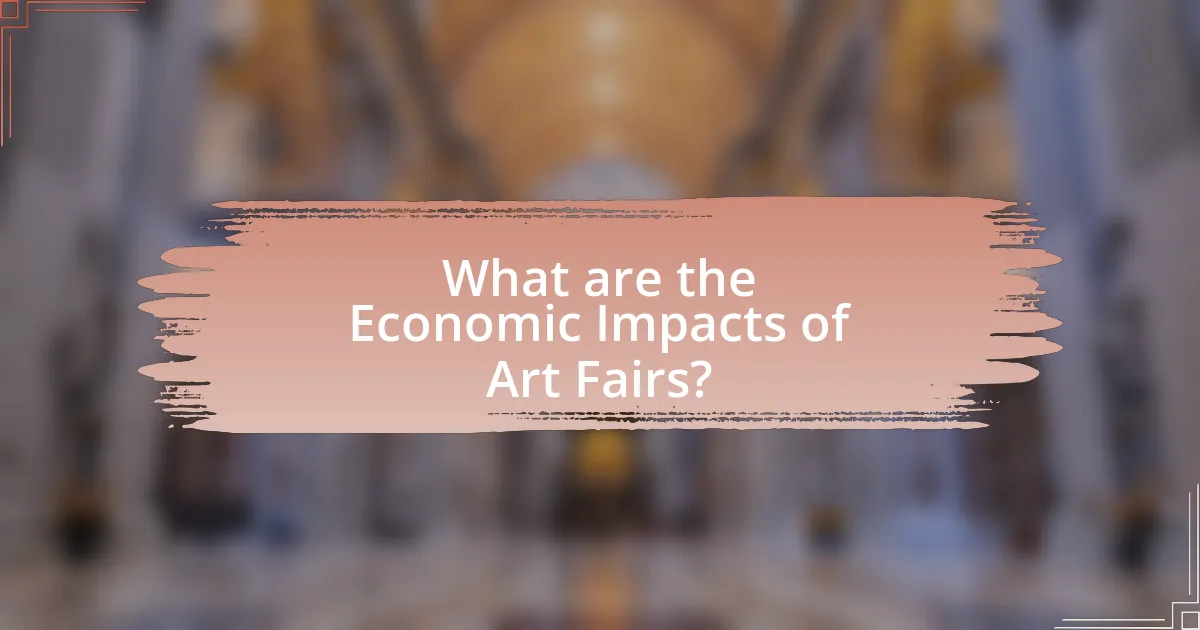
What are the Economic Impacts of Art Fairs?
Art fairs significantly contribute to local and global economies by generating revenue, attracting tourism, and facilitating art sales. They create economic activity through ticket sales, vendor fees, and hospitality services, which can lead to millions in local spending. For instance, Art Basel in Miami Beach reported an economic impact of approximately $500 million in 2019, showcasing how art fairs can stimulate local economies. Additionally, art fairs provide a platform for galleries and artists to sell works, often resulting in increased visibility and sales, which further supports the art market. This economic influence extends beyond immediate financial gains, as art fairs can enhance the cultural profile of a city, attracting future investments and tourism.
How do art fairs contribute to local economies?
Art fairs contribute to local economies by generating significant revenue through tourism, sales, and job creation. For instance, a study by the National Endowment for the Arts found that art fairs can attract thousands of visitors, leading to increased spending in local hotels, restaurants, and shops. Additionally, art fairs provide a platform for local artists and galleries to sell their work, which stimulates the local art market and fosters community engagement. The economic impact is further evidenced by the fact that art fairs often create temporary jobs in event management, hospitality, and security, thereby enhancing employment opportunities in the area.
What are the financial benefits for host cities?
Host cities experience significant financial benefits from hosting art fairs, including increased tourism revenue, job creation, and enhanced local business activity. For instance, art fairs attract thousands of visitors, leading to higher spending in hotels, restaurants, and retail shops. A study by the National Endowment for the Arts found that events like art fairs can generate millions in economic impact for host cities, with some cities reporting up to $100 million in direct spending during major events. Additionally, the influx of visitors creates temporary and permanent job opportunities in various sectors, further boosting the local economy.
How do art fairs stimulate tourism and related industries?
Art fairs stimulate tourism and related industries by attracting large numbers of visitors, including art collectors, enthusiasts, and tourists, which boosts local economies. For instance, the Art Basel fair in Miami Beach generates an estimated $500 million in economic impact annually, benefiting hotels, restaurants, and transportation services. Additionally, art fairs often feature local artists and galleries, promoting regional culture and increasing visibility for local businesses. This influx of visitors leads to increased spending in the area, thereby enhancing the overall economic landscape surrounding the event.
What is the relationship between art fairs and art galleries?
Art fairs and art galleries have a symbiotic relationship where art galleries often showcase their artists’ works at art fairs to reach a broader audience and enhance sales opportunities. Art fairs provide galleries with a platform to exhibit multiple artworks in a concentrated timeframe, attracting collectors, curators, and art enthusiasts, which can lead to increased visibility and potential sales. According to the Art Basel and UBS Global Art Market Report, art fairs accounted for 46% of the total sales in the global art market in 2022, highlighting their significance in promoting galleries and their artists.
How do art fairs affect gallery sales and visibility?
Art fairs significantly enhance gallery sales and visibility by providing a concentrated platform for galleries to showcase their artists and artworks to a diverse audience, including collectors, curators, and the general public. This exposure often leads to increased sales, as galleries can directly engage with potential buyers and generate interest in their represented artists. For instance, a study by Art Basel and UBS in 2022 reported that 70% of galleries participating in art fairs experienced increased sales during and after the event, highlighting the fairs’ effectiveness in driving revenue. Additionally, art fairs elevate a gallery’s profile within the art community, fostering relationships that can lead to future collaborations and opportunities, thereby solidifying their market presence.
What challenges do galleries face in the context of art fairs?
Galleries face several challenges in the context of art fairs, including high costs, intense competition, and logistical complexities. The financial burden of booth fees, shipping artworks, and travel expenses can strain gallery budgets, particularly for smaller galleries. Additionally, the competitive environment at art fairs means galleries must differentiate themselves to attract collectors, which can be difficult given the sheer number of exhibitors. Logistically, galleries must manage the installation and presentation of artworks within a limited timeframe, often under pressure, which can impact the quality of their display. These challenges highlight the demanding nature of participating in art fairs and the strategic planning required for galleries to succeed.
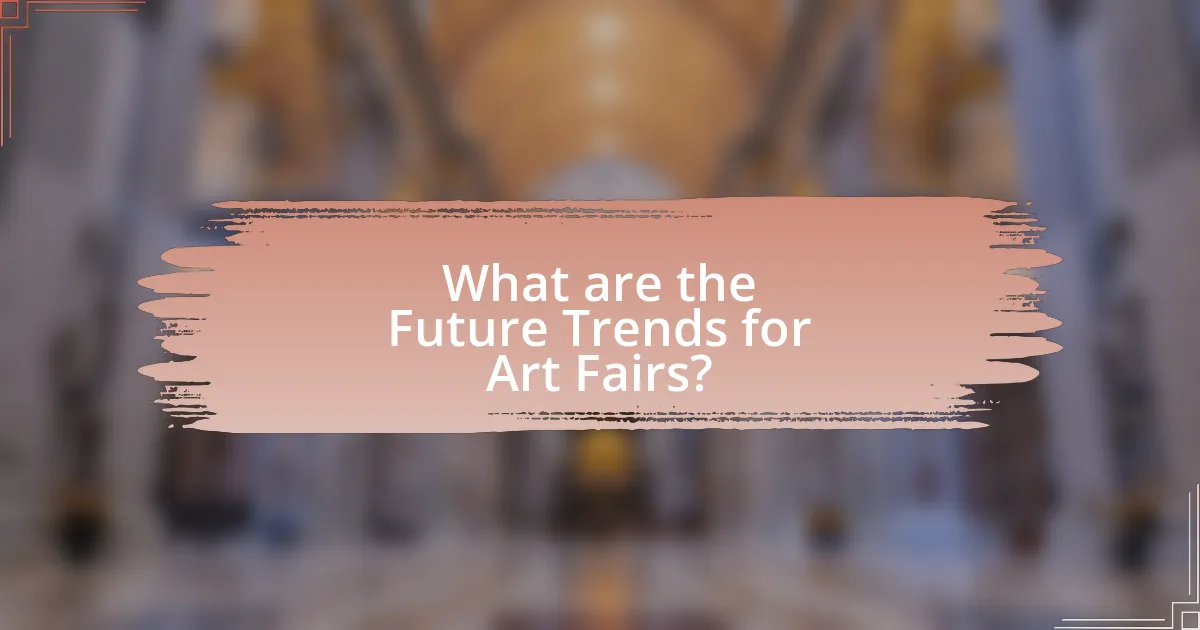
What are the Future Trends for Art Fairs?
Future trends for art fairs include increased digital integration, sustainability initiatives, and a focus on inclusivity. Digital integration is evident as art fairs adopt virtual platforms to reach broader audiences, exemplified by events like Art Basel’s online viewing rooms, which saw significant engagement during the pandemic. Sustainability initiatives are becoming crucial, with fairs like Frieze implementing eco-friendly practices, reflecting growing environmental concerns among artists and collectors. Additionally, inclusivity is gaining prominence, as fairs strive to represent diverse artists and communities, aligning with societal movements for equity and representation in the art world. These trends indicate a shift towards a more accessible, responsible, and connected art market.
How are digital platforms changing the landscape of art fairs?
Digital platforms are transforming the landscape of art fairs by expanding accessibility and enhancing engagement for both artists and collectors. These platforms allow art fairs to reach a global audience, enabling galleries and artists to showcase their work online, which increases visibility and potential sales. For instance, the rise of virtual art fairs, such as Art Basel’s Online Viewing Rooms, has demonstrated that digital formats can attract significant attendance, with Art Basel reporting over 100,000 visitors during its online events. This shift not only democratizes access to art but also allows for innovative presentation formats, such as interactive exhibitions and augmented reality experiences, which engage audiences in new ways.
What role does technology play in enhancing the art fair experience?
Technology significantly enhances the art fair experience by facilitating greater accessibility, engagement, and interaction for attendees and exhibitors. Digital platforms enable virtual participation, allowing a global audience to view and purchase artworks remotely, which expands market reach. For instance, during the COVID-19 pandemic, many art fairs transitioned to online formats, resulting in increased sales; Art Basel reported that 2020’s online viewing rooms attracted over 100,000 visitors. Additionally, augmented reality (AR) and virtual reality (VR) technologies provide immersive experiences, allowing visitors to visualize artworks in different contexts. These advancements not only improve visitor engagement but also streamline logistics for exhibitors, making the art fair experience more efficient and dynamic.
How are virtual art fairs impacting traditional models?
Virtual art fairs are significantly disrupting traditional art fair models by expanding accessibility and altering the sales dynamics. Unlike physical art fairs, which often limit attendance to a select audience, virtual platforms allow global participation, enabling galleries and artists to reach a broader audience. This shift has been evidenced by the success of events like Art Basel’s online viewing rooms, which reported increased visitor numbers and sales during their virtual editions. Additionally, the reduced overhead costs associated with virtual fairs allow galleries to offer more competitive pricing, further challenging traditional models that rely on high operational expenses.
What best practices should participants consider for successful engagement at art fairs?
Participants should prioritize networking, effective communication, and strategic presentation for successful engagement at art fairs. Networking allows participants to build relationships with artists, collectors, and other stakeholders, which can lead to future collaborations and sales opportunities. Effective communication is essential for conveying the value of artworks and engaging potential buyers, as studies show that personal interactions significantly influence purchasing decisions in art markets. Strategic presentation involves curating an appealing booth or display that highlights key pieces, as visually engaging setups attract more visitors and enhance the overall experience. These practices are supported by data indicating that well-executed presentations can increase foot traffic and sales at art fairs.
How can artists and galleries maximize their presence at art fairs?
Artists and galleries can maximize their presence at art fairs by strategically planning their exhibition space, engaging with visitors, and utilizing marketing tools effectively. A well-designed booth that showcases artwork prominently can attract more attention; for instance, studies show that visually appealing displays can increase visitor engagement by up to 30%. Additionally, artists and galleries should actively network with collectors and other artists during the event, as personal connections often lead to sales and collaborations. Utilizing social media before, during, and after the fair to promote their participation can further enhance visibility, with research indicating that 70% of art fair attendees use social media to discover new artists. By combining these strategies, artists and galleries can significantly enhance their impact at art fairs.
What strategies can collectors use to navigate art fairs effectively?
Collectors can navigate art fairs effectively by conducting thorough research prior to the event, which includes familiarizing themselves with participating galleries and artists. This preparation allows collectors to prioritize which booths to visit based on their interests and investment goals. Additionally, setting a budget helps collectors manage their spending and avoid impulsive purchases. Engaging with gallery representatives and asking informed questions can provide deeper insights into the artworks and market trends. Furthermore, attending preview days or VIP events can offer collectors early access to artworks and networking opportunities with other collectors and industry professionals. These strategies are supported by the fact that art fairs often showcase emerging trends and provide a platform for direct interaction with artists and galleries, enhancing the overall collecting experience.
